|
Chapter 10 (part B)
The houses and palaces, in which the
splendid terra-cottas were used, were large and spacious, for to them
belong all those mighty heaps of large stones hewn and unhewn, which
cover them to the height of from 13 to 20 feet.{156} These houses and
palaces were easily destroyed, for the stones were only joined with
earth, and when the walls fell everything in the houses was crushed to
pieces by the immense blocks of stone. The primitive Trojan people
disappeared simultaneously with the destruction of their town, for in
none of the succeeding layers of débris do we find the style of
architecture to consist of large blocks of stone joined with earth; in
none do we find the terra-cottas—with the exception of the round
articles in the form of tops and volcanoes—to possess any resemblance
with the excellent and artistic earthenware of the people of Priam.[158]
Upon
the site of the destroyed city new settlers, of a different
civilization, manners and customs, built a new town; but only the
foundation of their houses consisted of stones joined with clay; all of
the house-walls were built of unburnt bricks. Many such walls may be
seen at a depth of from 7 to 10 meters (23 to 33 feet) in the earthen
sides of my excavations; they have been preserved through the very fact
that the houses were burnt out, and the walls of unburnt bricks,
through the great heat, received a sort of brick-crust, or became
actually burnt bricks.
In my memoir of the 23rd of last month, I
spoke of a stone wall, found at a depth of 33 feet, which I hoped would
extend down to the primary soil. Unfortunately, however, it proved to
be merely the foundation of a house belonging to the immediate
successors of the ancient Trojans, and these foundations only extended
to a depth of 1¾ foot.
The remains of the ruined walls belonging
to ancient Troy had, of course, to be levelled by the new settlers,
whose mode of life and style of architecture were entirely different.
This explains how it is that, with the exception of a small wall in the
northern entrance of my large trench, I have hitherto not been able to
point out a single wall{157} belonging to ancient Troy; and that, until
now, I have only been able to present archæology with a few splendid
urns, vases, pots, plates, and dishes, and with but one bowl (crater).
(See Cut, No. 41, p. 74.) Yet I have found thousands of fragments of
other excellent vessels, the sad memorials of a people whose fame is
immortal.
I cannot conclude the description of the lowest
stratum without mentioning that among the huge blocks of stone, at a
depth of from 12 to 16 meters (39½ to 52½ feet), I found two toads; and
at a depth of 39½ feet a small but very poisonous snake, with a
scutiform head. The snake may have found its way down from above; but
this is an impossibility in the case of the large toads—they must have
spent 3000 years in these depths. It is very interesting to find in the
ruins of Troy living creatures from the time of Hector and Andromache,
even though these creatures are but toads.[159]
I must also draw
attention to the fact that I have found the ? twice on fragments of
pottery, one of which was discovered at a depth of 16 meters (52½
feet), the other at 14 meters (46 feet). The primitive Trojans,
therefore, belonged to the Aryan race, which is further sufficiently
proved by the symbols on the round terra-cottas.
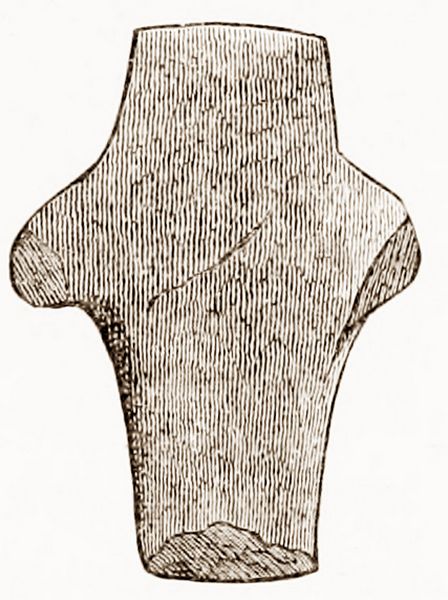
Fig. 110: Crude figurine (14m depth).
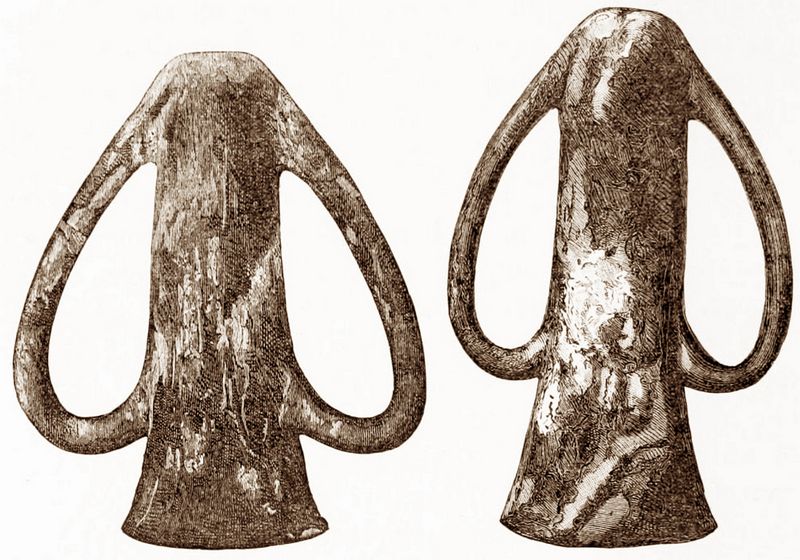
Figs.111,112: Double-handed Vases of Terra-cotta, from the Trojan Stratum (9m depth).
The
existence of the nation which succeeded the Trojans was likewise of a
long duration, for all the layers of débris at the depth of from 10 to
7 meters (33 to 23 feet) belong to it. They also were of Aryan descent,
for they possessed innumerable Aryan religious symbols. I think I have
proved that several of the{158} symbols were common to our ancestors at
a time when Germans, Pelasgians, Hindoos, Persians, Celts, and Greeks
still formed one nation. I found no trace of a double cup among this
people, but instead of it, those curious cups (vase-covers) which have
 a coronet below in place of a handle; then those brilliant red fanciful
goblets, in the form of immense champagne-glasses, with two mighty
handles on the sides: they are round below, so that they also can only
stand on their mouths. Further, those small covers, from about 4 to 4¾
inches high, with owls’ faces, with a kind of helmet on the lower end,
furnished with a high button or tuft, which is, no doubt, intended to
represent the crest of a helmet and served as a handle. This cup
likewise can only stand on its mouth.[160]
Fig.113: A Trojan Vase in Terra-cotta of a very remarkable form (8m depth).
Further, all those splendid
vessels of burnt earthenware—as, for instance, funereal, water, or wine
urns, 5 feet high and from 1¾ to 3¼ feet in{159} diameter; also smaller
funereal urns, plates, dishes, and vases, of exceedingly fanciful
forms, and from about 8 to 10 inches in height, with the owl’s face of
the tutelary goddess of Troy, two female breasts, and a navel, besides
the two upraised arms on each side of the head, which served as
handles; further, all of those vessels with a beak-shaped mouth, bent
back, and either short or long (fig.113).
Most of these vessels are round below,
so that they cannot stand; others have three feet; others, again, are
flat-bottomed. The neck of many is so much bent backwards that it
resembles a swan or a goose. To this class also belong all of those
globular and egg-shaped vessels, small and large, with or without a
neck like a chimney, which have a short ring on either side, and a hole
in the same direction in the lip, through which was passed the string
for suspending them; many have in addition three little feet. All are
of uniform colour, either brown, yellow, red, or black; some have rows
of leaves or twigs as decorations.
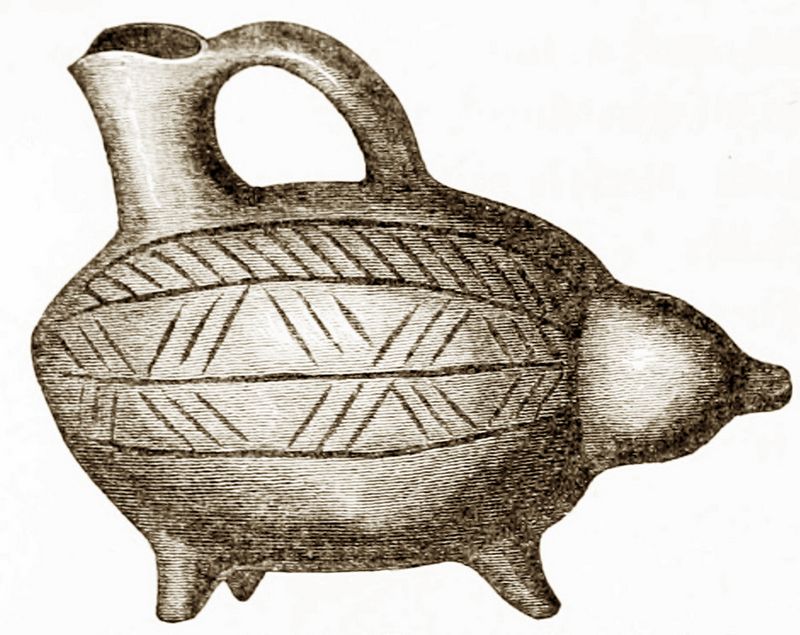 I also meet with very curious vases,
in the shape of animals, with three feet (fig.114). The mouth of the vessel is in
the tail, which is upright and very thick, and which is connected with
the back by a handle. Upon one of these last-mentioned vases there are
decorations, consisting of three engraved stripes of three lines each.
I formerly found the Priapus only at a depth of 7 meters (23 feet); but
a short time ago I found one at a depth of 13 meters (42½ feet). I now
find it again at 8 meters (26 feet){160} that is, among the ruins of
the nation of which I am at present speaking.
Fig.114: Engraved Terra-cotta Vessel in the form of a Pig (or Hedgehog?).7 m depth.
In these strata we also
meet with an immense quantity of those round terra-cottas (the whorls),
which, it is true, deviate from the wheel-shape of the articles found
on the primary soil owing to their greater thickness, and are also not
of such excellently-burnt clay as those; but, as anyone may convince
himself by examining the drawings, they are embellished with uncommonly
beautiful and ingenious symbolical signs.
Among these the Sun-god
always occupies the most prominent position; but the fire-machine of
our primeval ancestors, the holy sacrificial altar with blazing flames,
the holy sôma-tree or tree of life, and the rosa mystica, are also very
frequently met with here. This mystic rose, which occurs very often in
the Byzantine sculptures, and the name of which, as is well known, is
employed to designate the Holy Virgin in the Roman Catholic Litanies,
is a very ancient Aryan religious symbol, as yet, unfortunately,
unexplained.[161] It is very ancient, because I find it at a depth of
from 7 to 10 meters (23 to 33 feet) in the strata of the successors to
the Trojans, which must belong to a period about 1200 years before
Christ.[162]

The
sign which resembles the Phœnician letter “Nun” I found represented
sixteen times[163] upon one of those round{161} terra-cottas from a
depth of 8 meters (26 feet); for these signs stand in groups of four,
and by their position form a cross round the sun, or, if my present
supposition is right, round the nave of the wheel representing the
chariot of the sun. I also find the symbol of lightning in all the
higher strata up to 10 feet below the surface.
In all the strata, from
a depth of 33 feet up to 1¾ feet below the surface, I find engravings
of the sun with its rays innumerable times upon the round terra-cottas,
exactly as it is represented on the head of the Sun-god on the metopé
which I discovered when excavating the temple; but more frequently
still in circles of three, four, five, six or eight double, treble or
quadruple rising suns, and in by far the greater number of cases it
stands in the centre of four treble rising suns, which form a cross
round it. Hundreds of times I find the sun surrounded by stars in the
centre of a double or treble cross, which has a large dot on every one
of the four ends. These dots probably denote the four nails which fixed
the wooden frame by which the holy fire was prepared. At the depth of
from 10 to 7 meters (33 to 23 feet) I also found although more rarely,
five mystic roses in a circle round the sun.
One with signs (fig,115), which may
probably prove to be not merely symbols, but actual letters, I found at
a depth of 7 meters (23 feet).[164] I have still to mention those round
articles from the same depth, which have three mystic roses and two
sheaves of sun-rays in the circle round the sun. Further, from a depth
of 9 meters (29½ feet) I have several round pieces, upon which there
are 14 crooked sheaves of three sun-rays each, resembling the sails of
a windmill, which radiate in all directions from the sun, while the
compartments between the sheaves of rays are filled with stars. This
representation must indicate the rotation{162} of the wheel in the
course of the sun’s chariot in the heavens, that is, if the supposition
I before ventured to make, that the round objects represent the wheel,
is correct. Another, found at the same depth, has on one side three
holy sacrificial altars covered with flames, and a group of stars; on
the other side three similar altars, and a suastika forming a cross
round the sun.[165] There also occur some with only four curved sheaves
of rays, or two ? and two flaming altars in a cross round the sun;
there is again another upon which two crosses stand opposite each
other, and all the rest of the space round the sun (or round the nave
of the wheel) is filled with stars.

Fig.116: Terra-cotta Seal (1m depth).
In
the strata of the same nation I found also copper battle-axes, lances,
arrows, knives, and implements of different kinds, as well as a number
of moulds of schist and chlorite slate for casting these and many other
objects, some being of forms quite unknown to me. Seals of terra-cotta,
with crosses and other ornaments, are not peculiar to these strata, but
occur also at a depth of from 33 feet as far up as 1¾ feet below the
surface. We have also brought to light hand mill-stones of lava, which
are oval on one side and flat on the other, and some also of granite;
large and small hammers, axes, and balls with a hole through the
centre; further, mortars and pestles of diorite, and weights of
granite; quoits made of granite and other kinds of stone, with{163} a
hole through the centre for throwing them. Sling-bullets made of
loadstone, and great
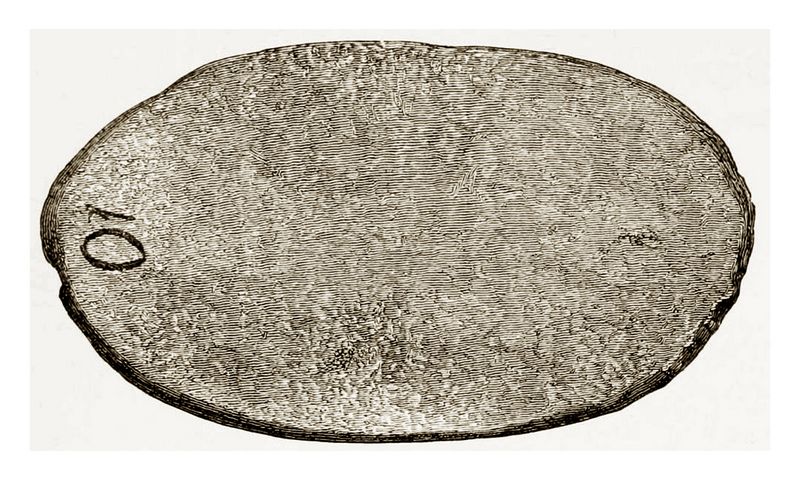
Fig.117: A Trojan Hand Mill-stone of Lava (10m depth).
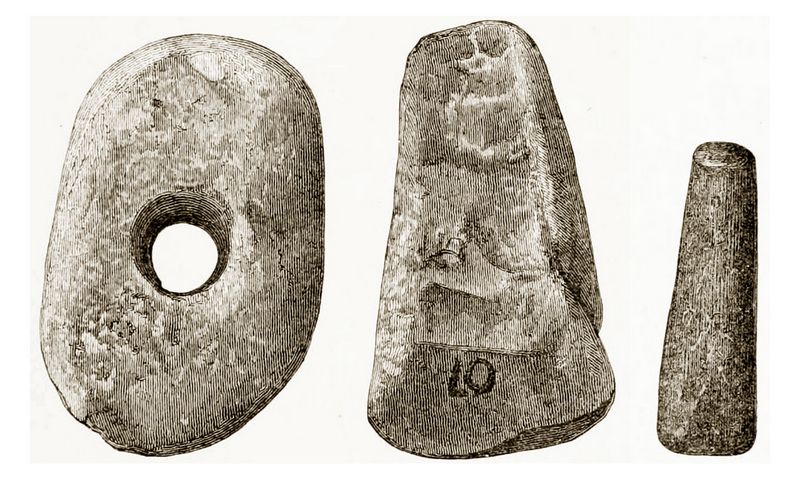
Figs. 118-120:
No. 118. A Piece of Granite, perhaps used, by means of a wooden Handle,
as an upper Mill-stone (10m depth). No. 119. A massive Hammer of
Diorite (10m depth). No. 120. Piece of Granite, probably used as a
Pestle. From the lowest Stratum (11-16m depth).
I
likewise find in these strata numerous idols of very fine marble, and
upon a number of them are engraved the{164} owl’s face of the Ilian
Athena and her girdle. At a depth of 8 meters (26 feet) we discovered a
terra-cotta idol of the same tutelary goddess; four horizontal strokes
on the neck seem to denote her armour; only one of the arms has been
preserved, which is in an upright position; two lines proceeding from
the arms and crossing each other over the body give her a warlike
appearance; her breasts are indicated by two points; her long hair is
distinctly marked at the back of the head.
At
a depth of 9½ meters (30½ feet) among the yellow ashes of a house which
was destroyed by fire, I found a large lump of thick wire, which I
believed to be copper wire, and therefore laid carelessly upon my
table; but when the lump was knocked down accidentally, a silver wire,
which held the packet together, broke, and out fell three bracelets,
one of which is simple, the second double, and the third treble: within
the last is a very artistic ornament and an ear-ring formed of six
wires, and these things must have been welded to the bracelet by the
heat of the conflagration, for it cannot possibly have been worn on the
arm as it is now.[166] The packet further contained a very pretty gold
ear-ring, which has three rows of little stars on both sides; then two
bunches of ear-rings of various forms, most of which are of silver and
terminate in five leaves. But the packet also contained several
ear-rings of the same form{165} made of electrum (??e?t???): three of
the ear-rings I know positively to be of electrum; there are, however,
probably several others of electrum among the two bunches which I dare
not attempt to loosen for fear of breaking the silver ear-rings which
have suffered very much from rust.
According to Pliny (H.N.
XXXIII. 23), and Pausanias (V. 12, §6) electrum was an artificial
compound of metals, four parts of gold and one of silver. The most
ancient Lydian coins are likewise made of electrum.
Nos. 122, 123, 124. Balls of fine red Agate; from the Trojan Stratum (9 M.).
At
the same depth I not unfrequently find balls of serpentine or porphyry
of nearly 2 inches in diameter, and with a hole through the centre.
Besides these we find spoons made of bone or terra-cotta, and great
quantities of instruments of ivory and bone for use as pins. I also
found a very artistically carved piece of ebony, which is certainly
part of a musical stringed instrument. I must also mention having
found, not only in these depths, but also up to 6 meters (20 feet)
below the surface, round pieces of terra-cotta with a hole running
longitudinally through them, 2¾ inches long and 2-1/3 inches broad; and
also pieces of terra-cotta from 2¾ to nearly 4 inches broad, flat below
and rounded off at the top, with two holes at the edge of the broad
surface, or with only one hole above running through from the side. All
of these articles have probably served as weights. In all of the strata
we discovered a number of the vertebræ of sharks, boars’ tusks,
antlers, and great quantities of the shells of small sea-mussels, of
which the Trojans and their successors at all times must have been very
fond.{166}
Footnotes:
[158]
Here, as well as in what goes before, Dr. Schliemann writes on the
supposition, which he afterwards abandoned, that the remains in the
lowest stratum are those of the Trojans of the Iliad.—[Ed.]
[159]
We believe that naturalists are now agreed that such appearances of
toads imprisoned for long periods are deceptive. Into what depths
cannot a tadpole (whether literal or metaphorical) wriggle himself
down?—[Ed.]
[160] This description itself suggests an inversion
of the so-called “cup,” which is, in fact, a vase-cover. For its form
see No. 74, on p. 115.—[Ed.]
[161] See Plate XXIII., No. 339; Plate XLVII., No. 478.
[162]
According to Dr. Schliemann’s later view these “successors to the
Trojans” were, as we have seen, the Trojans themselves.—[Ed.]
[163]The
drawing, Plate XLVII., No. 480, shows the sign 20 times in 5 groups of
4 each. This seems to be a similar type to the one described, but from
a lesser depth.—{Ed.}
[164] The inscription, which Professor
Gomperz has pointed out, is identical with that on Pl. LI., No. 496.
(See see p. 83-84 and Appendix.)—[Ed.]
[165] The types here described will be found on the Lithographs.
[Continue to Chapter 10, part C]
|
|